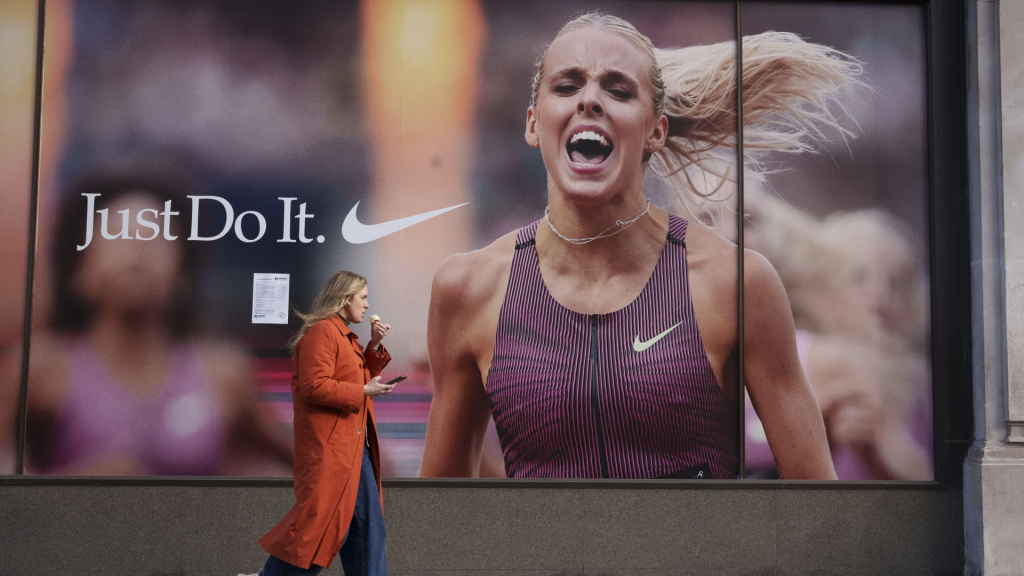Nike experienced a significant stock surge of 17% on Friday, fueled by the company’s assertion that it has navigated past the most challenging phase of its recent difficulties. This optimism followed an earnings report for the fiscal fourth quarter which exceeded expectations more than anticipated.
On Thursday, Nike confirmed that it would face its largest financial challenges linked to its turnaround strategy during this quarter, which helped to calm apprehensions among investors regarding potential impacts from President Donald Trump’s tariffs on crucial manufacturing regions such as China and Vietnam.
The fourth quarter results revealed a 12% decrease in sales and an 86% drop in net income, with profit margins also declining. However, CEO Elliott Hill assured stakeholders that the company is starting to recover and that the decline in both sales and profits will start to stabilize in the upcoming quarters.
“The results we’re reporting today in Q4 and in FY25 do not meet the Nike standard. However, as we stated three months ago, the initiatives we’re implementing through our ‘Win Now’ strategy are taking effect,” Hill remarked during an earnings conference call, signaling a transition for the company. “We anticipate improvement in our business outcomes from this point forward. It’s time to turn the page.”
Despite a drop in shares immediately following the earnings announcement due to limited details on the turnaround plan, the stock rebounded by over 10% during an extended trading session following a lengthy discussion with company executives and Wall Street analysts.
In addition to reassuring investors about the effectiveness of its turnaround efforts, Hill provided encouraging information regarding new product releases and initiatives aimed at reestablishing partnerships with wholesale retailers, which have been central to the company’s focus since his appointment in October.
Moreover, Hill discussed Nike’s strategy to recommence sales on Amazon, its first engagement in the platform since 2019, along with efforts to attract female customers—a key demographic for the brand.
During the quarter, Nike introduced products in over 200 female-focused retail locations, including a collaboration with WNBA star A’ja Wilson, which reportedly sold out within three minutes.
By Friday morning, investor sentiment surged, with various banks releasing positive assessments about the company. Notably, HSBC upgraded its rating on Nike from hold to buy, marking its first endorsement in three and a half years, and established a price target of $80—indicating a potential 28% increase from Thursday’s closing figure.
“This has been a long time coming, but we believe the turning point is finally here,” analyst Erwan Rambourg stated in a note to investors. “There is substantial evidence that Nike has a viable path toward sales recovery in the near future, alongside a potential improvement in its margins, despite facing tariff-related challenges.”
While Nike’s financial performance signals a recovery that aligns with Wall Street’s expectations, the situation remains delicate. The globally recognized sneaker brand is attempting to revitalize its growth amidst a volatile economic landscape characterized by fluctuating consumer confidence, escalating debt, tariffs, and large-scale deportations that cast uncertainty over spending and GDP.
For the ongoing quarter, Nike still anticipates a mid-single-digit percentage contraction in sales, consistent with projections by Wall Street for a 7% decline, according to LSEG.
The company also needs to address lingering inventory issues, particularly with its classic Dunks and Jordan lines. The efforts to liquidate outdated stock have exerted pressure on profit margins and sales, as deep discounts and clearance strategies have become necessary to manage excess inventory.
In fiscal 2025, concluding last month, sales from classic models like Air Force 1, Air Jordan 1, and Dunks plummeted over 20% compared to the corresponding period in the previous year. The decline intensified to 30% in the fourth quarter, resulting in an approximate $1 billion loss in sales, according to finance chief Matt Friend.
While inventory levels for Air Force 1 have shown signs of stabilization, Nike is still focused on reducing its stockpile of Dunks, a situation that is predicted to impact profits through the initial half of the current fiscal year, as indicated by Friend.
Both Hill and Friend acknowledged that Nike’s profitability will remain challenged throughout the first half of fiscal 2026 while the company deals with inventory issues and navigates the higher costs associated with tariffs. They noted an expectation of profit recovery in the latter half of the year.
However, the timeline for a return to meaningful sales growth remains uncertain. When queried about the possibilities for achieving revenue growth within this year, Hill refrained from providing a specific timeline.
“Given the current circumstances, we will take it 90 days at a time,” he stated. “We believe that full recovery will require time.”


























